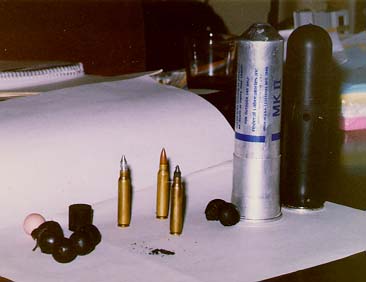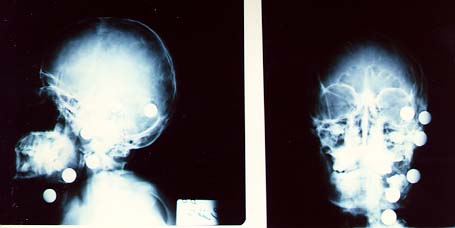

Selected Writings:
International Solidarity

January 16, 1989
By Chris Frazer
The day after the events in Balata, the youth of Ramallah demonstrated
to mark the anniversary of the founding of the Popular Front for the
Liberation of Palestine (PFLP), one of the many groups comprising the
PLO.
Shortly after 10:00 a.m., young people began to gather behind a church near the center of this city of 40,000 inhabitants.
At half-past the hour, a sharp whistle pierced the silence, and instantly the protesters donned Palestinian scarves that had been concealed in jackets and bags. They poured into the street chanting slogans and hurling stones at Israeli soldiers gathered at the other end of the road.
Out of nowhere, there appeared stone barricades and blazing tires intended to obstruct the IDF pursuit that was sure to follow.
Shots rang out, and the protesters broke ranks and fled in several directions, carrying us along to buildings where we hid. Meanwhile soldiers scoured the area searching for stragglers.
Ismail afterwards explained to significant facts about the demonstration. First, it represented the unity of the Palestinian people, since supporters of the Fatah faction of the PLO were among those in the protest. Tomorrow, PFLP supporters would rally for Fatah.
 Second, the protest represented a shift from the massive
demonstrations that characterized the early stages of the Intifada.
The IDF�s consistent use of live ammunition prompted the shift to
smaller simultaneous protests, since this reduced casualties, forced
the army to divide its forces, and made pursuit much more difficult.
Second, the protest represented a shift from the massive
demonstrations that characterized the early stages of the Intifada.
The IDF�s consistent use of live ammunition prompted the shift to
smaller simultaneous protests, since this reduced casualties, forced
the army to divide its forces, and made pursuit much more difficult.
Nevertheless the occupation and attempts to suppress the Intifada are exacting a terrible toll on the Palestinian people, a grim reality confirmed by a visit to the Al-Mokassed Palestinian Hospital in Jerusalem.
The hospital is a chilling experience, an indictment of the Israeli occupation which makes it clear that the army�s employment of so-called "non-lethal" ammunition and techniques of repression are quite capable of killing and maiming.
Plastic bullets are metal balls, about the size of marbles, which are simply coated in a thin-layer of plastic. One victim of these bullets, a nineteen year-old named Elias, was lucky not to die. He was chased down by soldiers who then shot him six times in the face � at point blank range.
Rubber bullets are regular bullets � but with tips coated in rubber over a metal core. Twelve year-old Ali died just days after we visited him. He�d been gunned down by soldiers while walking home with his brother to his farm near Nablus. The bullet entered his forehead, ploughed through his brain, and lodged in the back of his head.
More than five hundred Palestinians have died at the hands of the IDF since the uprising began, eight-seven percent of them males, and more than twenty percent of them children under the age of sixteen.
 When live ammunition of the "non-lethal" kind does not kill, it often
maims for life. Nineteen year-old Anwar was shot in the head with
high-velocity live ammunition. It left shrapnel, caused paralysis in
both legs, loss of control over his sphincter and bladder, and he can
no longer speak.
When live ammunition of the "non-lethal" kind does not kill, it often
maims for life. Nineteen year-old Anwar was shot in the head with
high-velocity live ammunition. It left shrapnel, caused paralysis in
both legs, loss of control over his sphincter and bladder, and he can
no longer speak.
CS gas carries two dangers. The canisters can kill when they strike the head or chest. Moreover it�s poison has been connected to several hundred fetal deaths and miscarriages in the last year.
Gas and bullets are not the only dangers. Of 46,000 Palestinians who reported injuries in conflicts with the IDF last year, fifty percent were related to the use of ammunition and tear-gas. But the remainder were caused by beatings inflicted by hand, with clubs, rocks, and fire-arms, or by burns, vehicular assaults, torture, and live burial.
Israeli soldiers forced sixteen year-old Ismail, of Nablus, to jump from the roof of a tall building. He sustained a complete spinal tran-section causing paralysis in both legs. Foreign medical associations have offered therapeutic aid, but Israeli officials have refused Ismail permission to travel.
Ahmad is forty-three years-old, the father of fourteen children. Soldiers arrested him, beat him, and then threw him from a moving jeep, and left him to die. Ahmad suffered multiple traumas, including fractures to all four limbs and a severe brain concussion. He is in a deep coma.
"At the beginning of the Intifada, the violence was mainly directed at the youth," said Dr. Ghanem, one of the Al-Makassed Hospital staff. "Now the violence is aimed against all ages, young and old, male and female.
"The army comes here often and we have many cases where new patients were arrested while still in critical condition," Ghanem continued. "On other occasions, the military governor has tried to close down our hospital."


 on February 5, 1999
on February 5, 1999
